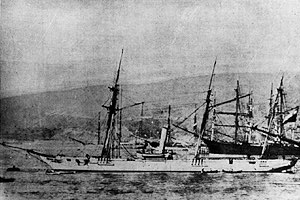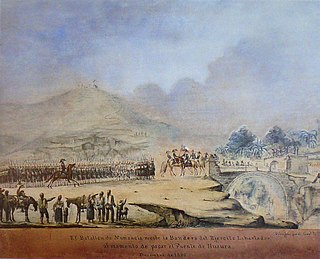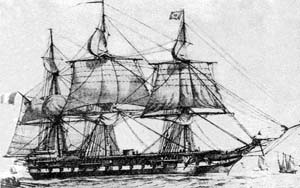
Huáscar is an ironclad turret ship owned by the Chilean Navy built in 1865 for the Peruvian government. It is named after the 16th-century Inca emperor, Huáscar. She was the flagship of the Peruvian Navy and participated in the Battle of Pacocha and the War of the Pacific of 1879–1883. At the Battle of Angamos, Huáscar, captained by renowned Peruvian naval officer Miguel Grau Seminario, was captured by the Chilean fleet and commissioned into the Chilean Navy.

The Battle of Callao occurred on May 2, 1866, between a Spanish fleet under the command of Admiral Casto Méndez Núñez and the fortified battery emplacements of the Peruvian port city of Callao during the Chincha Islands War. The Spanish fleet bombarded the port of Callao, and eventually withdrew without any notable damage to the city structures, according to the Peruvian and American sources; or after having silenced almost all the guns of the coastal defenses, according to the Spanish accounts and French observers. This proved to be the final battle of the war between Spanish and Peruvian forces.

The Chincha Islands War, also known as Spanish–South American War, was a series of coastal and naval battles between Spain and its former colonies of Peru, Chile, Ecuador, and Bolivia from 1865 to 1879. The conflict began with Spain's seizure of the guano-rich Chincha Islands in one of a series of attempts by Spain, under Isabella II, to reassert its influence over its former South American colonies. The war saw the use of ironclads, including the Spanish ship Numancia, the first ironclad to circumnavigate the world.

The Battle of Abtao was a naval battle fought on February 7, 1866, during the Chincha Islands War, between a Spanish squadron and a combined Peruvian-Chilean fleet, at the island of Abtao in the Gulf of Ancud near Chiloé Archipelago in south-central Chile. It was limited to a long-range exchange of fire between the two squadrons, as the allied ships, anchored behind the island, were protected by shallow waters inaccessible to the Spanish ships, whose gunnery, nevertheless, proved more accurate and inflicted damage to the Chilean and Peruvian ships.

USS Catawba was a single-turreted Canonicus-class monitor built for the Union Navy during the American Civil War. Completed shortly after the end of the war, Catawba was laid up until sold to her builders in 1868, and then resold to the Peruvian Navy. Renamed BAP Atahualpa, the ship participated in the defense of main port of Peru, Callao, during the War of the Pacific. When the city of Lima was taken by Chilean troops in 1881, she was scuttled to prevent her capture. Atahualpa was later refloated and used as a storage hulk until scrapped in the early 20th century.

The schooner Virgen de Covadonga was a ship that participated in the Chincha Islands War and the War of the Pacific, under Spanish and Chilean flags. She was launched in 1859. Covadonga hit a floating mine and sank off Chancay in 1880.

The Liberating Expedition of Peru was a naval and land military force created in 1820 by the government of Chile in continuation of the plan of the Argentine General José de San Martín to achieve the independence of Peru, and thus consolidate the independence of all former Spanish-American colonies. It was vital to defeat the Viceroyalty of Peru—the center of royalist power in South America—from where royalist expeditions were sent to reconquer the territories lost to the independence fighters.

BAP Apurímac was the second steam frigate of the Peruvian Navy, built in England in 1855 along with the steam schooners Loa and Tumbes as a part of a major build-up of the Navy during the government of President José Rufino Echenique. A veteran of two wars and many internal conflicts, due to her age she served as training ship in Callao port from 1873 until January 17, 1881, when she was scuttled along with the rest of the Peruvian Navy to prevent capture by Chilean troops who had occupied the port after the defeat of the Peruvian Army in the battles of San Juan and Miraflores.

Carlos Arnaldo Condell De La Haza was a Chilean naval officer and hero of the Battle of Punta Gruesa during the start of the War of the Pacific.

The corvette Abtao was a wooden ship built in Scotland during 1864 of 1.600 tons and 800 IHP. She fought in the War of the Pacific and was in service for the Chilean Navy until 1922.

The First Chilean Navy Squadron was the heterogeneous naval force that temporarily terminated Spanish colonial rule in the Pacific and protagonized the most important naval actions of in the Latin American wars of independence. The Chilean revolutionary government organized the squadron in order to carry the war to the Viceroyalty of Perú, then the center of Spanish power in South America, and thus secure the independence of Chile and Argentina.

The corvette Magallanes was ordered by the Chilean government after the disastrous consequences of the War against Spain in 1864-1866 and the rising border conflict with the neighboring countries at the end of the 1870s.

The capture of the frigate Esmeralda was a naval operation conducted on the nights of 5 and 6 November 1820. A division of boats with sailors and marines of the First Chilean Navy Squadron, commanded by Thomas Cochrane, stealthily advanced towards Callao and captured the ship through a boarding attack. Esmeralda was the flagship of Spanish fleet and the main objective of the operation. She was protected by a strong military defense that the royalists had organized in the port.

SMS Augusta was a wooden steam corvette built in the 1860s, the lead ship of the Augusta class. She had one sister ship, Victoria; the ships were armed with a battery of fourteen guns. Augusta was laid down in 1863 at the Arman Brothers shipyard in Bordeaux, France, and was launched in early 1864. Originally ordered by the Confederate States Navy, her delivery was blocked by the French Emperor Napoleon III, and she was instead sold to the Prussian Navy in May 1864. The Prussians had been in search of vessels to strengthen their fleet before and during the Second Schleswig War against Denmark, but Augusta arrived too late to see action in the conflict.
Agustín Manuel Hipólito Orella Macaya, known simply as Manuel Hipólito Orella, was a Chilean naval officer who made a career in the Chilean Navy. He was one of the first Chilean midshipmen who entered the nascent navy in 1818. He joined the First Chilean Navy Squadron and participated in the naval war for the independence of Chile and Peru. He also spent time in the Chilean Army in the infantry branch. Furthermore, he held several important positions in the navy until his death in 1857.

BAP Unión was a corvette of the Peruvian Navy, originally ordered by the government of the Confederate States of America during the American Civil War. Built in France it was bought by the Peruvian Navy and during its service participated in the Chincha Islands War and in the War of the Pacific in which it was scuttled following the Blockade of Callao to prevent it falling into Chilean hands.

Aurelio García y García was a Peruvian marine, diplomat and politician. García was a friend and comrade-in-arms of Miguel Grau, Manuel Ferreyros and Lizardo Montero, all of whom were known as the Four Aces of the Peruvian Navy. He was also elected Mayor of Lima in 1877. He was also a man of wide culture, who was fully fluent in the English language and who had scientific inclinations.

The Pilcomayo was originally a Peruvian gunboat involved in several actions during the War of the Pacific. Captured by the Chilean navy on November 18, 1879, it was repaired and participated in the blockade of the Peruvian ports. After the war it was used for hydrographic research, then as a training ship. In service until 1909, it was finally used as a pontoon at Talcahuano.

Nicolás Federico Portal was a Peruvian captain and politician during the War of the Pacific. He is known for being the captain of the BAP Unión throughout the war.


















